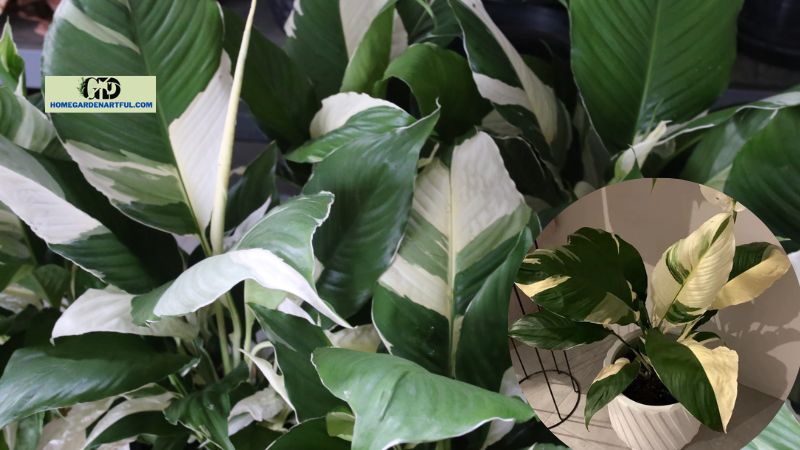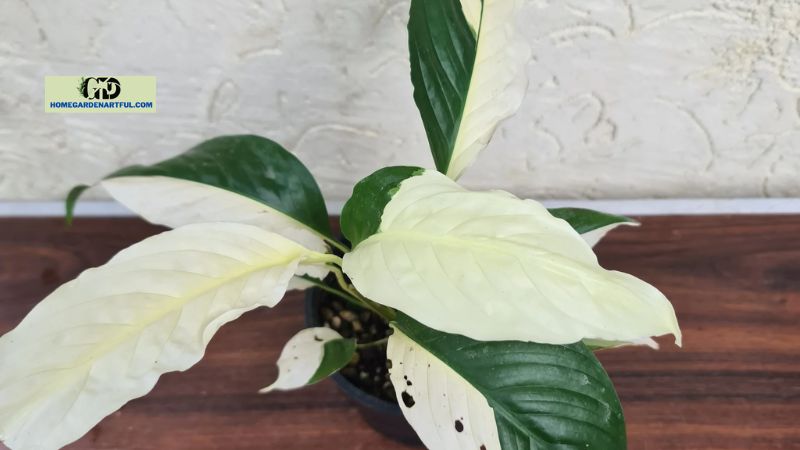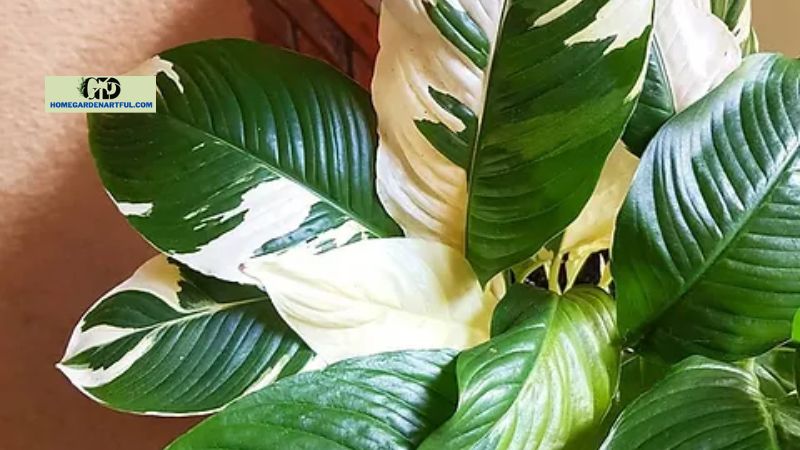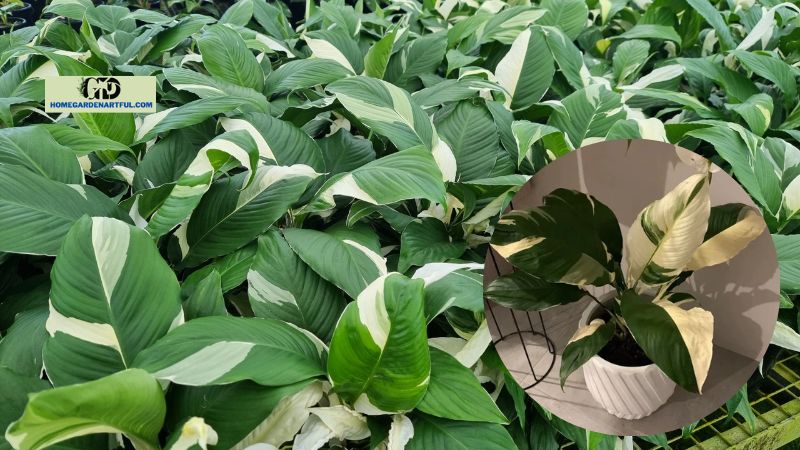The Picasso Peace Lily is an exquisite substitute for its more prevalent spathiphyllum relatives and a genuine gem among plants. Each leaf of the Picasso is a one-of-a-kind work of art with its remarkable multicolored variegation. The real stuff has been uncovered, even if these exotic plants may be difficult to find in the United States.
It’s crucial to give your variegated peace lily the proper care if you want it to flourish in its new environment. But don’t worry; if you understand the fundamentals, these plants are simple to look after and will rapidly become a priceless addition to any collection of uncommon plants.
Interestingly, over-caring about a Picasso peace lily could be the only issue you have! You can be confident that your Picasso will keep growing well even if you skip one or two waterings because these plants are exceptionally resistant and can endure extended periods of neglect.
Homegardenartful.com invites you to learn more about what makes this Picasso peace lily such a special and in-demand plant. We’ll explain why this plant is essential for any plant enthusiast as well as our care and maintenance advice. Prepare to be in awe of the Picasso peace lily’s breathtaking splendor!
How to take care of Picasso Peace Lily

Lighting
Picasso peace lilies like bright, indirect sunshine, especially from a south-facing window. This is because they are highly variegated plants. The white variegation may momentarily change to green in order to absorb more sun, but they can also survive lower light levels. No matter what, your Picasso will flourish as long as it has plenty of brilliant light, and the more light it has, the more variation it will make. Just be careful not to place it directly in the sun as this can burn the foliage.
Your Picasso will thrive in a bathroom with a window if you’re fortunate enough to have one, and it will benefit from the added humidity.
Using Grow Lights: If you choose to use grow lights, we advise white LED lights over purple ones because the latter are frequently too intense for Picasso’s taste. To prevent burning the leaves, make sure that you keep the lights at least 12 inches away from them. Your Picasso peace lily will flourish and produce its gorgeous variegated foliage with the correct lighting, giving it a unique addition to your plant collection.
Watering

Picasso peace lilies flourish when their regular watering schedule resembles their natural environment. They require soil that is regularly moist but not soggy because this might lead to the roots rotting. The leaves may droop if the soil dries out too much between waterings, but they will regrow after being watered. Although they might occasionally be a little dramatic, their personality only serves to enhance their appeal.
distilled water or regular water? Tap water contains fluoride and chlorine, which can ultimately char the leaves and roots of spathiphyllums. If at all possible, we advise using distilled water or a Brita filter-type water filtering system. It’s not technically necessary, though, and tap water is still usable as long as the chemicals are given time to vaporize by letting it rest outside for a few hours.
Optimal Soil For Growing? Picasso peace lilies may grow in a variety of soil types. In local, perlite, peat moss, sphagnum moss, and coco coir, have successfully cultivated them. Your Picasso will flourish in soil that drains quickly and holds only a little water. Looking for a soil mixture that feels thick and won’t compact when squeezed in your hands is a decent rule of thumb.
It is a reasonable choice to consider hydroponically growing your Picasso peace lily in water. In fact, I experimented with one of my Picassos for four weeks by keeping it in an aquarium. To my delight, the plant showed vigorous growth with strong stems, and new growth was developing at a respectable rate. I credit the fish tank filter’s regular provision of water and nutrients as well as movement for success. Change the water at least once every week to keep it clear of algae and decay. An excellent alternative is to grow your Picasso peace lily in an aquarium. So go ahead and experiment with this innovative new method of plant growth!
Temperature
It’s crucial to keep the temperature consistently above 60 degrees Fahrenheit all year long in order to ensure that your Picasso peace lilies grow robust and healthily. You might observe delayed growth and droopy leaves if it gets any colder than that. During the winter, make sure to keep them away from any drafts in order to preserve their roots from the cold. The plant may have trouble recovering if its roots are harmed. While keeping the temperature in the room above 60 degrees is preferable, a temperature of about 70 degrees is also acceptable. Your Picasso peace lilies will flourish if you give them a cozy and secure setting.
Humidity

Picasso peace lilies prefer high humidity levels, ideally between 70 to 80%. If you reside in a dry region, spraying yourself twice daily with distilled water can assist in raising humidity levels. An additional choice is to put the plant in a moist area, like a bathroom, or to use a pebble tray underneath the pot. For those that have inside greenhouses, raising the humidity to ideal levels is simple.
Spathiphyllum are recognized for their versatility and can tolerate somewhat lower humidity levels even if high humidity is desirable. It’s crucial to remember, though, that a dry atmosphere could put some strain on the plant. For instance, our Picasso peace lilies are still flourishing where we live in Spokane, Washington, where the relative humidity inside is typically around 45%.
Fertilizer
The native habitat of peace lilies is the rainforest floor, which has a very nutrient-poor environment due to regular rainfall that washes away the majority of the soil’s nutrients. As a result, they don’t need a lot of additional nutrients because they are naturally evolved to grow in these circumstances. In contrast to other houseplants, they may be more susceptible to some fertilizer chemicals and less tolerant of high nitrogen levels.
Although it isn’t required, we advise using a water-soluble fertilizer that has been diluted to half its strength and fertilizing your peace lily about every two months. Overfeeding your peace lily can lead to quick, lush growth that is challenging to control.
Repotting your peace lily every year with new soil will ensure that it has enough slow-release nutrients for the following year. You can make sure your plant gets access to the nutrients it requires in this way without running the risk of overfeeding.
Maintenance
As your peace lily matures, you might observe that some of the lower leaves start turning yellow and gradually wither. There is no need to be concerned about this process; it is normal. To encourage new growth, just cut off the yellowing leaves with a pair of clean, sharp scissors.
Furthermore, peace lilies frequently overrun their containers over time. It’s time to repot the plant into a larger container when you see that the roots are beginning to crowd the pot or grow out of the drainage holes. By doing this, the plant will be able to grow its roots and continue to thrive.
Troubleshooting
The Picasso peace lily is often a hardy and pest-resistant houseplant. However, like all plants, it can get dry and crispy on its leaves, which may draw pests, if you don’t give it regular watering or expose it to extremely low humidity. On the other side, excessive watering can cause root rot or, worse yet, completely destroy the plant. To maintain the health of your peace lily, it is crucial to find a balance between watering it and giving it enough humidity.
For instance, if the humidity level drops too low or the plant is allowed to dry out excessively, the leaves may be harmed and the plant may become vulnerable to pests.
Pests and diseases
Pests attracted by the Picasso peace lily are uncommon, although dry or dead leaves might serve as a nesting site for spider mites or thrips. It’s crucial to routinely remove any dead foliage if you want to avoid this. Try increasing your misting and watering frequency if you see brown or crispy edges on the leaves as this could indicate water stress. Pests can be kept at bay by keeping a close eye on your plant’s health and taking immediate action to solve any problems.
What happens if you overwater Picasso Peace Lily
If you see a sudden change in the color of several leaves, especially new ones close to the top of the plant, it may be an indication that the roots are being deprived of oxygen, which could lead to a bacterial or fungal infection. This could happen if the soil mixture is porous and the pot doesn’t have drainage holes, particularly following watering. Although it could already be too late to salvage the plant, you might try repotting it right away in fresh soil after cutting any dead or mushy roots.
Alternatively, you might re-water the plant using a hydrogen peroxide solution that has been diluted. In addition to its antibacterial and antiviral qualities, hydrogen peroxide breaks down into oxygen and water, giving the roots much-needed oxygen.
Conclusion
Although rare, variegated Peace Lilies can still be found with a little internet searching. If you do get one, be sure to provide it with adequate lighting.
Also, keep in mind that there is still no assurance that it will consistently produce leaves with multiple colors. Don’t consider the variegation on your Peace Lily something you can manage. Consider it a unique and priceless gift.


